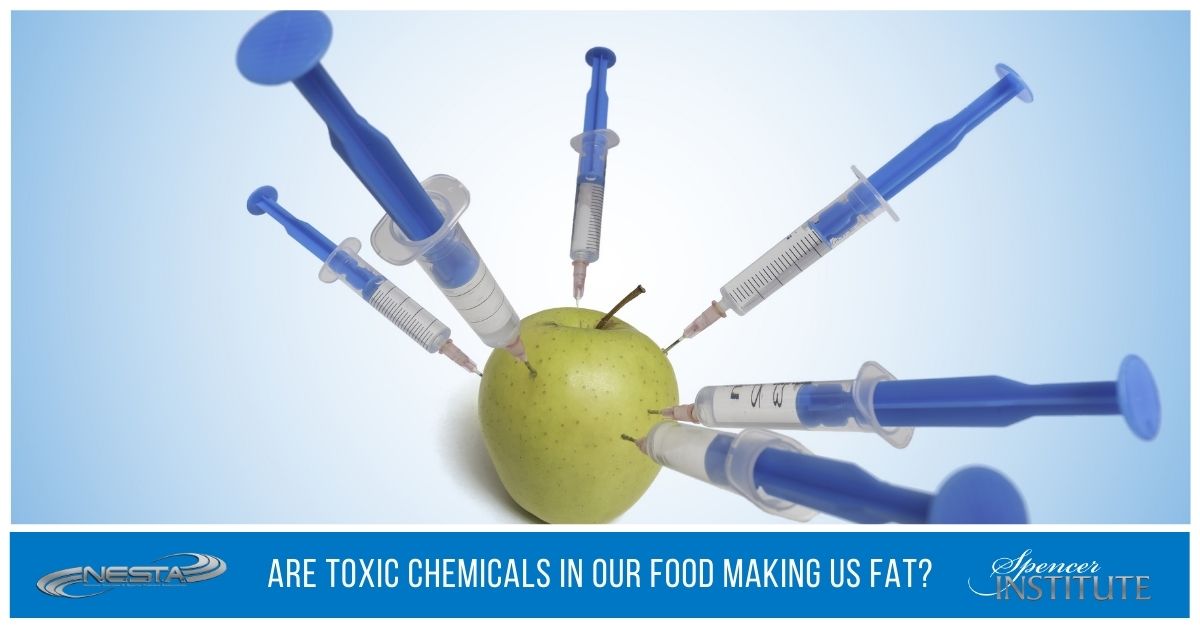Are Toxic Chemicals in Our Food Making Us Fat?
One obvious factor is our change in lifestyle. Americans move less in our day-to-day lives than in the past, but we often still eat the same amount of food. These excess calories are then stored away as fat.
Recent research, however, reveals a more complex causality for the obesity epidemic, with science suggesting that environmental chemicals also play a role. Certain chemicals are suspected of altering when, why and how much the body creates fat cells or stores fat in existing cells.
Chemicals found in our food, home and work environments and in the products we buy are among the substances linked to how our body creates or stores fat.
Approximately 15 chemicals and classes of chemicals have been shown to cause weight gain in animal studies. Some of these include:
Bisphenol A: found in canned food linings, polycarbonate plastics and thermal paper
PBD Es: brominated flame retardants used in products such as furniture and electronics
Perchlorinated biphenyls (PCBs): found in certain fish and industrial workplaces
Some organochlorine pesticides: used in agriculture and found in certain foods
Some phthalates: found in plastics, cosmetics and household cleaners
Some surfactants (PFOAs): found in food wrappers, stain-resistant and non-stick surfaces
Nicotine: from tobacco
High fructose corn syrup: in many foods in place of sugar
What do we know about obesity from chemical exposure?
Obesity results from the dysfunction of one or more of the endocrine systems that control eating behavior, fat cell development and number, and metabolism. Thus a dysfunction in the control of the brain, adipose tissue, liver, skeletal muscle or gastrointestinal tract function could upset the delicate endocrine balance, resulting in susceptibility to weight gain. In addition, it is now clear that susceptibility to obesity may start in utero or in childhood. A disturbance while the tissues and organs are developing could lead to increased susceptibility to weight gain.
Persistent, Bioaccumulative, and Toxic Chemicals
Chemicals that last a long time in the environment and build up in our bodies are known as bioaccumulative and toxic chemicals (also called PBTs or POPs). Some of these chemicals, such as PCBs and DDT, have been banned for many years but are still commonly found in the environment, in food, and in people. Others, like some flame retardants and “Teflon chemicals,” are still in use. Studies have associated persistent toxic chemicals with obesity and diabetes.
An analysis of data collected by the CDC on more than 2000 U.S. adults found a very strong association between exposure to these chemicals and diabetes: people with the highest concentrations were 37 times more likely to have diabetes than those with the lowest concentrations.
A study of the adult daughters of women who ate PCB- and DDT-contaminated fish from Lake Michigan found that the daughters with greater prenatal exposure to DDT breakdown product DDE were more likely to be overweight or obese.
Chemicals can Disrupt Your Hormones
An endocrine disruptor is a synthetic chemical that when absorbed into the body either mimics or blocks hormones and disrupts the body’s day-to-day functions. This disruption can happen through altering normal hormone levels, stopping or stimulating the production of hormones, or changing the way hormones travel through the body, thus affecting the functions that these hormones control.
Some science and medicine have known about these problems for some time. The pharmaceutical and biotechnology industries have been creating these types of drugs and chemicals for years, but no one has established a causal connection between drugs/chemicals and obesity prevalence until recently.
Experts estimate each of us carries 300–500 chemicals in our bodies. Reducing exposure to synthetic and or toxic chemicals and hormones decreases our bodies’ daily burden of what U.K. physician Dr. Paula Baillie-Hamilton has dubbed “chemical calories.” She states:
“One theory posits that the reason why chemical calories are fattening is because they actually seem to reduce your food requirements—not because they add to your food in terms of quantity or nutrition. This could help explain how we are all eating less, yet still getting fatter.”
What Can we do About this Challenge?
Toxic chemicals that can cause obesity, cancer, reproductive problems, and learning disabilities are in the products we use every day. That’s because federal law on chemicals takes a “don’t ask, don’t tell” approach: EPA can’t require companies to test chemicals for safety, nobody’s telling what chemicals are even in products, and chemicals with known hazards can be used in places we live, work, or play.
The good news is, people from all over the nation are getting organized and asking government officials (in the USA, Congress hears these concerns) to update the Toxic Substances Control Act of 1976. More than 200 state, national, and local organizations have joined together to form the Safer Chemicals, Healthy Families coalition. Together, these states have been somewhat successful in encouraging Congress to take action. In recent times, Congress has introduced legislation intended to fix what some see as a flawed chemical management system. The coalition now operates to work closely with Congress to ensure that any new law does the following:
- requires that only the safest chemicals be used in products
- ensures that all chemicals are fully tested for safety,
- phases chemicals with known hazards out of commerce.
Since chemicals in our food supply come from a variety of sources it’s critical to buy organic produce, meats, poultry and dairy.
Transitioning to a Healthy Organic Diet
If you want your client to actually create lasting changes in their quest to live healthily we have to push for them to be honest with themselves. Only then can positive changes begin to take hold. At times, our clients say that they are not aware of what they need to do in order to make changes. This isn’t new in coach-client relationships. But at the root of this thinking is a benign type of ignorance that we all have.
What if you were to ask a client to answer the following question as part of their assessment: “What am I pretending not to know?” This direct and honest question can get things started. You can be more efficient if you can cut through the unknown factors and dive into understanding why knowledge and awareness are being ignored. Have clients think of ways to apply this to every aspect of their life, beginning with your health behaviors and food choices. This allows your client to take full responsibility for, and control of, their efforts to live a green life.
Getting Started
Learn more about becoming a Certified Holistic Living Coach here >>> https://spencerinstitute.com/certification-programs/holistic-life-coach-certification/
Becoming a Certified Wellness Coach is the perfect addition for the fitness professional who wants to offer more all-inclusive wellness services to clients. The time is now for you to enjoy this exciting and rewarding career, which offers you personal fulfillment while improving the lives of others.
Our programs are open to anyone with a desire to learn and help others. There are no prerequisites.
That’s it for now.
Take action!
PS: Click here to see many helpful business/career resources











